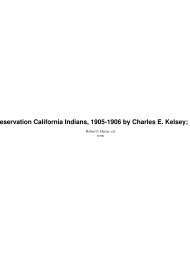YA summer '01 - Yosemite Online
YA summer '01 - Yosemite Online
YA summer '01 - Yosemite Online
You also want an ePaper? Increase the reach of your titles
YUMPU automatically turns print PDFs into web optimized ePapers that Google loves.
• Increased entrance fees, along with steep lodging<br />
and meal costs, may price park visits beyond the<br />
reach of families on limited incomes.<br />
“It’s a sad situation,” said Ron Ich, sitting on the rear<br />
bumper of his hatchback in the Paradise Inn parking lot<br />
at Mount Rainier. “It costs $80 for gas, $20 a night to<br />
camp, you’ve got food, and there’s all the time packing<br />
and unpacking. It’s hard to just pile in the car and go.”<br />
Ich’s wife, Jane, said families also may be avoiding<br />
<strong>summer</strong>time trails awash in people and cars circling<br />
parking lots for spaces.<br />
“I don’t think people get out to parks as much as they<br />
used to, and I know that’s part of it,” she said.<br />
VIEW THROUGH THE WINDSHIELD<br />
Of all federal lands, national parks keep clearest track of<br />
recreation use. Their numbers suggest that Americans<br />
today experience wild places less through slouching tents<br />
and singed marshmallows than windshield tours.<br />
The number of people camping in national parks hit<br />
its lowest point in more than 25 years in 2001, a decline<br />
of 30 percent from its high of 8.9 million two decades<br />
earlier. The number staying overnight — either camping<br />
or in lodges — has dipped by 20 percent since 1994. That<br />
means more people visit parks only for the day.<br />
Camping, it turns out, is a pursuit of the affluent.<br />
Surveys of campers in California by Dean Runyan<br />
Associates of Portland, Ore., showed more than twothirds<br />
have incomes of $50,000 or more. And those<br />
camping in national parks outspend all others.<br />
But as dedicated park visitors age, they may opt for<br />
more comfortable outings elsewhere.<br />
“As the population ages, camping isn’t such a big<br />
draw,” said Butch Street, who tracks visitor statistics for<br />
the Park Service. “Roughing it is when the Hilton’s full,<br />
you stay at the Holiday Inn.”<br />
Urban youths and young adults who have grown up<br />
with video games and the Internet also may not visit<br />
parks and wilderness like their parents did. More than<br />
eight of 10 campers questioned in California grew interested<br />
in the outdoors as children, but more than half of<br />
camping parties had no children.<br />
Few people younger than 30 had tents pitched.<br />
“They have the world in the keyboard at their fingertips,”<br />
said Gramann, the Texas A&M professor. “The traditional<br />
family vacation to the national parks isn’t as<br />
relevant to people growing up today.”<br />
TIME, CROWDING CITED<br />
A national study by Northern Arizona University found<br />
two main reasons people did not visit national parks.<br />
First, they were short on time. Second, they thought of<br />
parks as places to look at scenery, but didn’t know what<br />
else they could do there.<br />
They also viewed parks as crowded and travel to them<br />
as expensive.<br />
“The challenge before the parks is to get involved in<br />
education and tell people what they have to offer,” said<br />
Fred Solop, who led the study.<br />
Parks looking for their next generation of visitors may<br />
face a difficult test. Visitors to national parks have long<br />
tended to be white, highly educated and affluent. But<br />
Latinos and other ethnic groups who have not frequented<br />
parks as much are driving population growth in<br />
many parts of the country.<br />
“There’s a matter of long-term political sustainability<br />
of the parks,” Gramann said. “These are new voters who<br />
really don’t know anything about the national parks. So<br />
the challenge to the Park Service is to reach out to them.”<br />
That’s changing the way parks serve visitors.<br />
North Cascades National Park in Washington has<br />
enlarged campsites for extended families — often ethnic<br />
minorities — that travel together, Superintendent Bill<br />
Paleck said. Crews also have built more handicappedaccessible<br />
trails, drawing couples with young children<br />
who might not use more rugged routes in the largely<br />
undeveloped park.<br />
Instead of just discussing troop movements at Civil<br />
War battlefields, Gramann said, rangers also talk about<br />
the era’s struggle over slavery, making talks relevant to<br />
more visitors.<br />
“The United States, at that time, was working out<br />
what it meant to be free, and that’s part of the story,” he<br />
said.<br />
More diverse parks may be needed. The few with a<br />
Latino connection deal mainly with Spanish conquest,<br />
but a bill in Congress would consider adding sites related<br />
to Cesar Chavez and the farm labor movement.<br />
Michael Milstein is a reporter for the Portland<br />
Oregonian, where this article first appeared. We<br />
thank Mr. Milstein and the Oregonian for their<br />
permission to reprint it.<br />
10 YOSEMITE ASSOCIATION, FALL 2003




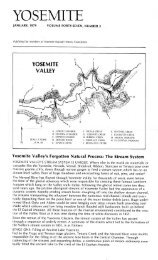
![(March 1982) [PDF] “We Are Pleased to Announce†- Yosemite Online](https://img.yumpu.com/51299748/1/190x242/march-1982-pdf-aeuroewe-are-pleased-to-announceaeur-yosemite-online.jpg?quality=85)
![[PDF] Old Horny, Yosemite's Unicorn Buck - Yosemite Online](https://img.yumpu.com/51269869/1/184x260/pdf-old-horny-yosemites-unicorn-buck-yosemite-online.jpg?quality=85)
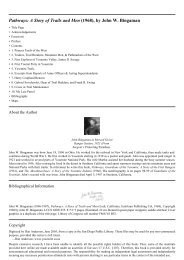
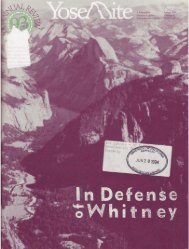
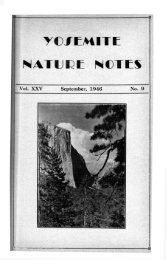
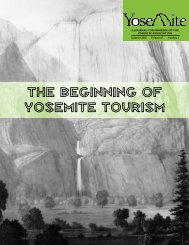
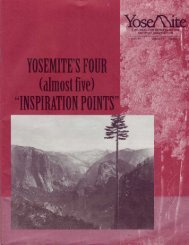
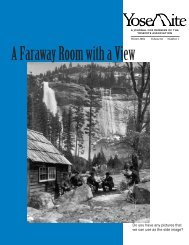
![1985 [PDF] - Yosemite](https://img.yumpu.com/48128837/1/184x260/1985-pdf-yosemite.jpg?quality=85)

